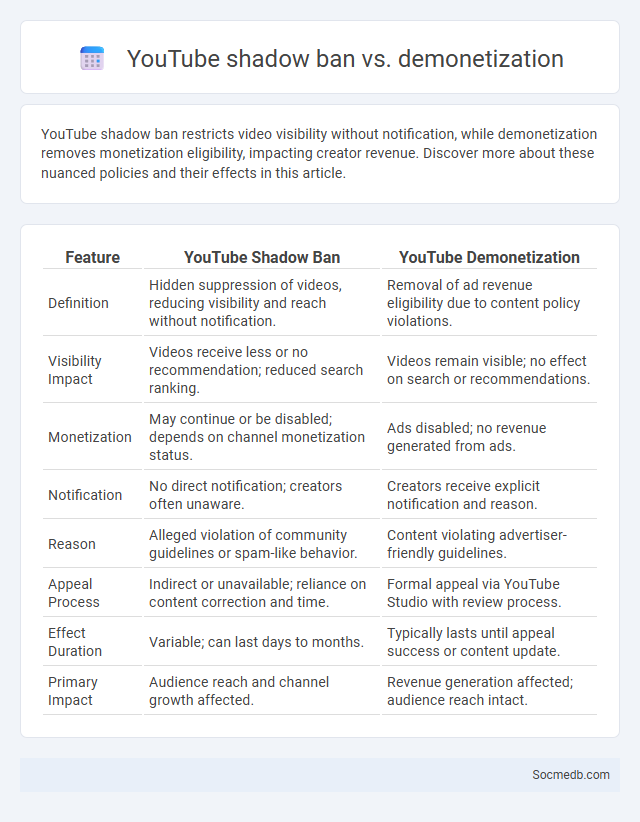
Photo illustration: YouTube shadow ban vs demonetization
YouTube shadow ban restricts video visibility without notification, while demonetization removes monetization eligibility, impacting creator revenue. Discover more about these nuanced policies and their effects in this article.
Table of Comparison
| Feature | YouTube Shadow Ban | YouTube Demonetization |
|---|---|---|
| Definition | Hidden suppression of videos, reducing visibility and reach without notification. | Removal of ad revenue eligibility due to content policy violations. |
| Visibility Impact | Videos receive less or no recommendation; reduced search ranking. | Videos remain visible; no effect on search or recommendations. |
| Monetization | May continue or be disabled; depends on channel monetization status. | Ads disabled; no revenue generated from ads. |
| Notification | No direct notification; creators often unaware. | Creators receive explicit notification and reason. |
| Reason | Alleged violation of community guidelines or spam-like behavior. | Content violating advertiser-friendly guidelines. |
| Appeal Process | Indirect or unavailable; reliance on content correction and time. | Formal appeal via YouTube Studio with review process. |
| Effect Duration | Variable; can last days to months. | Typically lasts until appeal success or content update. |
| Primary Impact | Audience reach and channel growth affected. | Revenue generation affected; audience reach intact. |
Understanding YouTube Shadow Bans
YouTube shadow bans restrict the visibility of your videos without notifying you, significantly reducing engagement and reach on the platform. These bans often result from violations of community guidelines or algorithmic factors, causing your content to be hidden from search results, recommendations, and subscriber feeds. Understanding how shadow bans operate enables you to adjust your content strategy and maintain your channel's growth and audience interaction.
What Is YouTube Demonetization?
YouTube demonetization refers to the process where YouTube disables or removes monetization features from a channel or video, preventing creators from earning ad revenue. This action typically occurs when content violates YouTube's advertiser-friendly guidelines, copyright policies, or community standards. Demonetization impacts creators by reducing their revenue potential and visibility on the platform.
Shadow Banning: Definition and Impact
Shadow banning refers to the practice where social media platforms covertly restrict a user's content visibility without their knowledge, significantly reducing engagement and reach. This technique impacts content creators by limiting audience growth, causing frustration due to unexplained drops in interaction. Understanding shadow banning is crucial for users aiming to maintain online presence and avoid unintentional breaches of platform guidelines.
Key Differences: Shadow Ban vs Demonetization
Shadow ban limits the visibility of your social media content without notifying you, often affecting engagement and reach silently, while demonetization directly impacts your revenue by preventing monetization features on platforms like YouTube. Shadow banning targets content distribution algorithms to reduce exposure, whereas demonetization removes financial incentives, typically due to policy violations related to guidelines or advertiser preferences. Understanding these distinctions helps you navigate platform rules and maintain both audience presence and earnings effectively.
Signs You’re Experiencing a YouTube Shadow Ban
A YouTube shadow ban typically results in a severe drop in video views, likes, and comments without notification from the platform. If your content suddenly appears missing from search results or recommended feeds, it often indicates shadow banning by YouTube's algorithm. Monitoring audience engagement metrics and sudden decreases in channel traffic can help identify these signs early.
Why Does YouTube Demonetize Videos?
YouTube demonetizes videos primarily to comply with advertiser-friendly guidelines and maintain a safe platform for brands. Content that includes sensitive topics, inappropriate language, or controversial subjects often faces demonetization to protect advertisers from negative associations. Ensuring your videos align with YouTube's policies helps maintain monetization and supports your channel's revenue growth.
Effects of Shadow Banning on Channel Growth
Shadow banning on social media platforms significantly stunts channel growth by reducing content visibility without user awareness, causing declines in follower engagement and reach. Algorithms suppress shadow-banned accounts, limiting their exposure to new and existing audiences, which results in decreased organic growth and hindered community building. Creators affected by shadow banning often experience stagnation or reduction in key metrics such as views, likes, and comments necessary for sustainable channel development.
How to Avoid YouTube Shadow Bans
To avoid YouTube shadow bans, consistently follow the platform's community guidelines by avoiding misleading content, spammy behavior, and copyright violations. Engage genuinely with your audience by creating original videos and fostering authentic interactions rather than relying on automated bots or clickbait tactics. Ensure your content metadata, including titles, tags, and descriptions, accurately reflect your video to maintain visibility and prevent algorithmic suppression of your channel.
Recovering From Demonetization on YouTube
Recovering from demonetization on YouTube requires diversifying income streams, optimizing video content for higher engagement, and adhering strictly to community guidelines to avoid future penalties. Leveraging crowdfunding platforms, sponsored content, and merchandise sales can offset revenue losses while maintaining a loyal subscriber base. Consistently analyzing YouTube Analytics helps creators identify content trends that maximize ad revenue and viewer retention post-demonetization.
Best Practices to Stay Compliant on YouTube
To stay compliant on YouTube, your content must adhere strictly to the platform's Community Guidelines, including avoiding copyright infringement and misleading metadata. Consistently using accurate descriptions, tags, and thumbnails helps prevent strikes and ensures your videos reach the appropriate audience. Understanding YouTube's monetization policies and regularly reviewing updates protects your channel from penalties and potential demonetization.
 socmedb.com
socmedb.com